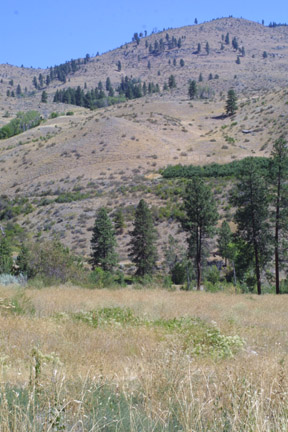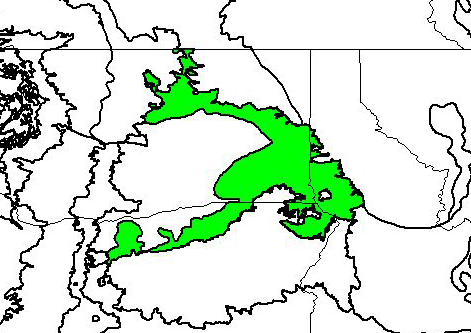
Lower Methow valley, Washington (c) 2005 Steven J. Baskauf
Bioimages home (click on an image to enlarge)
view
this page in its intended navigation context
Palouse grasslands
(WWF
ecoregion NA0813)

Lower Methow valley, Washington
(c) 2005 Steven J.
Baskauf

Source of bioregions data:
Olson, D. M. and
E. Dinerstein. The Global 200: Priority ecoregions for global conservation. (PDF
file) Annals of the Missouri Botanical Garden 89:125-126.
Distinctiveness (1=highest,4=lowest): 2 (regionally
outstanding)
This grassland is distinctive due to its combination of dominant grass species
and the presence of shrubs.*
Conservation Status (1=most endangered, 5=most
intact): 2 (endangered)
Less than 1% of this ecoregion is intact. Nearly all has been converted to
agriculture. Remaining patches are highly fragmented.*
 | Agropyron spicatum or | (bluebunch wheatgrass) |
 | Stipa comata or | (needle and thread) |
Agropyron smithii (western wheatgrass)
Associated habitats
Grassland with sage, near Chelan, Washington





Left three images: In this area, elements of the nearby the Snake-Columbia shrub
steppe ecoregion (notably sage) are present in the grassland. Middle right: The
aspect influences the distribution of species, with south-facing slopes having
primarily grass with scattered shrubs. Far right: north-facing slopes have
a significant number of trees in addition to the grass and shrubs. (c) 2005 Steven J.
Baskauf
hires hires hires
hires hires
Higher elevation grassland, Methow Valley, Washington

As the upper Methow Valley extends northwestward into the Cascade Mountains
leeward forests ecoregion, conifers typical of that region become more prevalent
on the north-facing slopes. Eventually they cover all of the slopes, leaving the
valley bottom as the only grassland areas. (c) 2005 Steven J.
Baskauf
hires
Riparian area, Methow River near Methow, Washington


(c) 2005 Steven J.
Baskauf
hires hires
* Ricketts, T.H., E. Dinerstein, D.M. Olson, C.J. Loucks, et al. (1999) Terrestrial Ecoregions of North America: A Conservation Assessment. World Wildlife Fund - United States and Canada. Island Press, Washington, D.C. pp. 275-276.
Except as noted, images copyright 2002-2005 Steve Baskauf - Terms of use